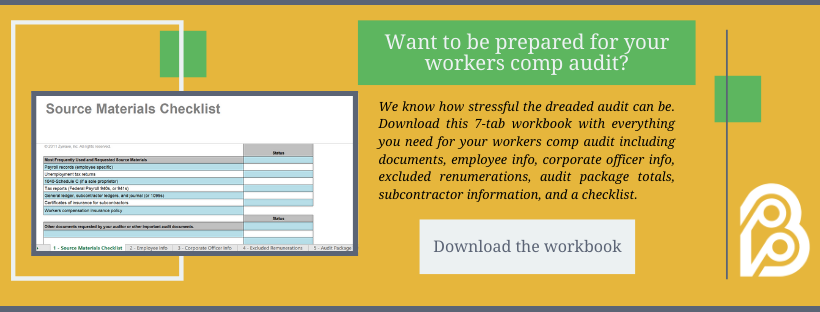5 Steps to Get Through Your Workers Comp Audit
Unless you’re new to business ownership, you are probably familiar with workers compensation insurance audits.
But, if you’re like most people, you’re probably still confused by them.
The annual audit can often be very complex, stressful and time consuming for many businesses. However, understanding how your policy premium is determined, what is needed for the audit and how to avoid any mistakes along the way is critical to avoiding costly overcharges.
Fortunately for you, here at Berry Insurance, we have been through it a couple times (more like a couple thousand). We’re here to simplify the worker’s compensation audit for you, explaining what it is, and how you can prepare so you’ll have an error-proof audit experience.
Table of contents:
- Step 1: Understand How Your Premium is Determined
- Step 2: Prepare Your Documents
- Step 3: Avoid Common Mistakes
- Step 4: Schedule/complete your audit appointment
- Step 5: Obtain the Auditor Worksheets
What is a workers comp audit?
At the start of your policy, your worker’s compensation premium is estimated based on your projected exposures for the policy term. When the policy expires, you’ll be asked to provide your actual exposures for the policy term. This is your audit.
It is designed so you do not overpay (or underpay) for your coverage. In other words, it makes sure you only pay for the exposures you actually had.
This is a good thing! We love accuracy, don’t we?
Even though the process is beneficial, doesn’t mean it is not confusing. There are a lot of materials to prepare and a lot of mistakes to avoid.
So, let’s get into the 5 steps you should take to prepare for your audit.
Step 1: Understand How Your Premium is Determined
Before your audit, you’ll want to make sure you know what your premium is, and how it was determined.
There are several factors that play into determining your cost.
Gross payroll
First and foremost, you will be charged for the gross payroll of your employees during the policy period.
Each employee will be associated with a 4-digit code that represents their primary job duties. For example code 8810 is used for clerical work while code 5190 is for electrical work. Each code is assigned a rate, which is determined by the State, and may be adjusted annually.
Location
Your policy is also rated based on the states in which you perform work or have locations.
You will want to be sure to keep a detailed payroll record of the work performed in each state, by employee.
Owners, officers, partners, or members of an LLC will have their payroll capped at a payroll amount as determined by the state, which also typically is adjusted annually. And depending on how your corporate structure is set up, owners or officers will either be automatically covered on the policy, or will need to make a written election to be included.
Previous claims experience
Your policy also may have a charge (or credit) for your previous claims experience.
They determine this charge or credit based on something called an Experience Modification Factor. Your experience mod. is calculated six months prior to the start of your policy, and unfortunately, can also be calculated incorrectly. Your insurance agent should be monitoring this calculation and confirming its accuracy before your policy is put in place.
Fees and assessments
Lastly, there are a few fees and assessments that are charged as part of the policy.
These are things such as terrorism, expense constant, and Department of Industrial Accident assessments. These fees are outside of your control, but it’s important to note that while they are included in your overall costs, they won’t change by much as a result of the audit.
These factors are all calculated at the beginning of your workers compensation policy to determine your premium.
Step 2: Prepare Your Documents
As soon as your policy starts, you’ll want to begin compiling the necessary documents to complete your workers compensation audit. Here are the documents you’ll typically be asked to provide:
- Last four quarterly 941s
- Any 1099s issued
- Payroll reports or spreadsheet showing individual employee names, job duties, states worked, and gross payroll for the policy period
- Overtime pay, if any
- List of all owners/officers names, titles, job duties, gross payroll, ownership percentage and # of working weeks
- List of subcontractor names, job duties and payroll during the policy period
- Certificates of Insurance (COI) for all subcontracted labor — Note: If the owner is the person doing the work, make sure that the COI states the owner has coverage for himself/herself or that the COI indicates that officers are not excluded
Step 3: Avoid Common Mistakes
Unfortunately, mistakes happen. Even if you have all the documentation ready ahead of the audit, there are still ways in which your audit can be calculated incorrectly. Through human error, the auditor could assign the wrong code to an employee, forget to take out overtime, charge for a subcontractor they shouldn’t have, etc.
To avoid this, be sure you have the following organized before the audit:
- Double-check all your COIs for subcontractors to make sure that none are without coverage, or are for dates that don’t include your policy term. If that is the case, request updated COIs immediately.
- Make sure your payroll records do NOT include any “excluded remuneration” – overtime, rewards, tips, severance, officer exemptions, payments for active military duty, etc.
With these considerations, your audit should (in most cases) be calculated correctly. For more tips on mistakes you should avoid during your audits, read this guide: 8 Common Mistakes To Avoid on Your Insurance Audit.
Step 4: Schedule/complete your audit appointment
Hopefully your audit will be completed electronically or over the phone, and you’ll be able to expedite the process. But, if you have to schedule an in-person audit, there are a few extra steps you should take to make sure the process goes extra smoothly:
- If you can’t be available to meet with the auditor, assign a knowledgeable and friendly person to work with the auditor. This should be an employee, not an independent bookkeeper or accountant.
- Treat the auditor as a welcomed guest. Set them up in a clean, clutter-free work space.
- Do not portray this visit as an inconvenience.
- Present the auditor with printed copies of all your records.
- Do not offer any gratuitous information. Answer questions specifically and without elaboration.
- Do not allow the auditor to roam freely or unattended around your office or facility.
- Try and schedule the audit for the afternoon, preferably on a Friday.
We know some of these suggestions might seem strange because if the point of an audit is to simply make sure you paid for the right workers compensation, why should how the auditor feels at the appointment affect your audit? Well, to be honest, it shouldn’t, but …it could. Creating a simple, stress-free environment for your auditor will just help the process go more smoothly. Plus it’s just courteous!
Step 5: Obtain the Auditor Worksheets
Even if all the steps above are completed successfully, mistakes can still happen! Why? Well, partially due to human error, but also in part because many auditors do not work for the insurance company, but rather a third-party. More often than not they are not well-versed in classification rules or state-specific coverages, resulting in costly mistakes for you.
The only way to accurately confirm that your audit was completed correctly is to obtain a copy of the auditor’s worksheets.
You should ask the auditor for their business card, and request a copy of their worksheets before they leave. This step is critical as their worksheets cannot be released to your insurance agent. So if you don’t request them, you might not ever see them.
Review the auditor worksheets to make sure everything seems correct. If anything seems questionable, consult your insurance agent.
Get through your audit with ease:
We know that audit time of the year can be stressful.
But if you understand your premium, keep the required information organized, anticipate common mistakes, and navigate the appointment properly, the process can actually be fairly painless!
Of course, if you have any questions or concerns about your business specifically, your agent can help. Feel free to reach out to us so we can help you feel even more confident about your upcoming audit.
Also, we have something else that might be able to help! Download the following workbook with resources that can help you prepare for a seamless workers compensation audit.


.jpg)
